Frequency and Time Dependence of Linear Polarization in Turbulent Jets of Blazars
Abstract
1. Introduction
- A plasmoid would likely have a slowly changing mean magnetic field direction, which might be altered in the observer’s frame if the plasmoid accelerates, causing a modest (<180°) rotation of the position angle χ of LP [12]. The LP is expected to show only slight, if any, frequency dependence across the optical bands.
- A moving shock amplifies the magnetic field perpendicular to the shock normal (i.e., parallel to the shock front). If the shock normal is aligned with the jet axis, and if the magnetic field ahead of the shock is highly tangled, χ will be observed to be parallel to the jet axis unless the shock is viewed exactly face-on (in which case the degree of LP could be nearly zero if the pre-shock magnetic field is disordered). If the shock normal is oblique to the jet axis, χ can be oblique as well [13]. Acceleration of electrons (which includes any positrons that are present) at the shock front, followed by radiative energy losses that are more severe for higher post-shock energies, causes stratification such that the higher-frequency emission occurs over a smaller layer behind the shock front. This steepens the spectrum and increases both the mean LP and the level of variability [14]. It is possible that the ordering of the magnetic field transverse to the shock normal decays with distance from the shock front, in which case the LP can become weaker and change in position angle [15]. The gradient of maximum electron energy with distance from the shock front then causes a decrease in LP as the transverse field decays that is more pronounced at higher frequencies. Subsequently, the degree of LP reaches a minimum of zero followed by a switch of χ to 90° from the jet direction, both of which occur first at higher frequencies.
- A helical magnetic field tends to produce LP with χ oriented either parallel or perpendicular to the jet axis [16]. An off-axis emission feature (e.g., a slow magnetosonic shock) can cause rotation of χ by >180° as it spirals down the helical field pattern, whose field lines propagate at nearly the speed of light [17]. Unless the twist of the helical field reverses, such rotations should always be in the same sense (e.g., clockwise).
- Plasma with a randomly tangled magnetic field should have a low mean degree of LP, , where is the number of magnetic cells, each with a random magnetic field direction [18] and , which depends weakly on the slope of the synchrotron spectrum, is typically in the range of 68–75%. The observed value of P is predicted to fluctuate over time with a standard deviation [19]. The value of χ should vary across the full range, often mimicking systematic rotations that can exceed 180°, but occurring in random directions (i.e., either clockwise or counter-clockwise).
- Dong et al. [22] carried out simulations of emission resulting from kink instabilities, finding that the degree of LP is anti-correlated with the flux density during flares. Independent simulations of kink instabilities by [23]) feature time-dependent differences between the optical and X-ray LP parameters of blazars whose X-ray emission is mainly synchrotron radiation.
2. Methods: Observations
2.1. Multi-Frequency Optical Observations of Linear Polarization
2.2. VLBI Images with the Very Long Baseline Array
2.3. Gamma-ray and X-ray Fluxes
2.4. Optical Flux Density Measurements with the Liverpool Telescope
3. Results of Observations
4. Discussion
4.1. Polarization of Synchrotron Emission from a Turbulent Relativistic Jet
4.2. Results of TEMZ Simulations
4.3. Comparison of Simulations with Data
5. Predictions of Polarization of X-ray Synchrotron Emission from Blazars
6. Conclusions
Supplementary Materials
Author Contributions
Funding
Institutional Review Board Statement
Informed Consent Statement
Data Availability Statement
Acknowledgments
Conflicts of Interest
References
- Blandford, R.D.; Znajek, R. Electromagnetic extraction of energy from Kerr black holes. Mon. Not. R. Astron. Soc. 1977, 179, 433–456. [Google Scholar] [CrossRef]
- McKinney, J.C.; Narayan, R. Disc-jet Coupling in Black Hole Accretion Systems I. General Relativistic Magnetohydrodynamical Models. Mon. Not. R. Astron. Soc. 2007, 375, 513–530. [Google Scholar] [CrossRef]
- Tchekhovskoy, A.; Narayan, R.; McKinney, J.C. Efficient Generation of Jets from Magnetically Arrested Accretion on a Rapidly Spinning Black Hole. Mon. Not. R. Astron. Soc. 2011, 418, L79–L83. [Google Scholar] [CrossRef]
- Meier, D.L.; Koide, S.; Uchida, Y. Magnetohydrodynamic Production of Relativistic Jets. Science 2001, 291, 84–92. [Google Scholar] [CrossRef] [PubMed]
- Vlahakis, N.; Königl, A. Magnetic Driving of Relativistic Outflows in Active Galactic Nuclei. 1. Interpretation of Parsec-Scale Accelerations. Astrophys. J. 2004, 605, 656–661. [Google Scholar] [CrossRef]
- Zamaninasab, M.; Clausen-Brown, E.; Savolainen, T.; Tchekhovskoy, A. Dynamically Important Magnetic Fields near Accreting Supermassive Black Holes. Nature 2014, 510, 126–128. [Google Scholar] [CrossRef] [PubMed]
- Nalewajko, K.; Begelman, M.C. The Effect of Poloidal Velocity Shear on the Local Development of Current-Driven Instabilities. Mon. Not. R. Astron. Soc. 2012, 427, 2480–2486. [Google Scholar] [CrossRef]
- Homan, D.C.; Lister, M.L.; Kovalev, Y.Y.; Pushkarev, A.B.; Savolainen, T.; Kellermann, K.I.; Richards, J.L.; Ros, E. MOJAVE XII: Acceleration, Collimation of Blazar Jets on Parsec Scales. Astrophys. J. 2015, 798, 134. [Google Scholar] [CrossRef]
- Jorstad, S.G.; Marscher, A.P.; Mattox, J.R.; Wehrle, A.E.; Bloom, S.D.; Yurchenko, A.V. Multi-Epoch VLBA Observations of EGRET-Detected Quasars and BL Lac Objects: Superluminal Motion of Gamma-Ray Bright Blazars. Astrophys. J. Suppl. 2001, 134, 181–240. [Google Scholar] [CrossRef]
- Daly, R.A.; Marscher, A.P. The Gas Dynamics of Compact Relativistic Jets. Astrophys. J. 1988, 334, 552–559. [Google Scholar] [CrossRef]
- Königl, A. Relativistic jets as X-ray, gamma-ray sources. Astrophys. J. 1981, 243, 700–709. [Google Scholar] [CrossRef]
- Blandford, R.D.; Königl, A. Relativistic Jets as Compact Radio Sources. Astrophys. J. 1979, 232, 34–48. [Google Scholar] [CrossRef]
- Hughes, P.A.; Aller, H.D.; Aller, M.F. Oblique Shocks as the Origin of Radio to Gamma-ray Variability in Active Galactic Nuclei. Astrophys. J. 2013, 735, 81. [Google Scholar] [CrossRef]
- Marscher, A.P.; Gear, W.K. Models for High-Frequency Radio Outbursts in Extragalactic Sources with Application to the Early 1983 Millimeter to Infrared Flare of 3C273. Astrophys. J. 1985, 298, 114–127. [Google Scholar] [CrossRef]
- Tavecchio, F.; Landoni, M.; Sironi, L.; Coppi, P. Probing Shock Acceleration in BL Lac Jets through X-ray Polarimetry: The Time-Dependent View. Mon. Not. R. Astron. Soc. 2020, 498, 599–608. [Google Scholar] [CrossRef]
- Lyutikov, M.; Pariev, V.I.; Gabuzda, D.C. Polarization and Structure iof Relativistic Parsec-scale AGN Jets. Mon. Not. R. Astron. Soc. 2005, 600, 869–891. [Google Scholar] [CrossRef]
- Vlahakis, N. Disk-Jet Connection. In Blazar Variability Workshop II: Entering the GLAST Era; Miller, H.R., Marshall, K., Webb, J.R., Aller, M.F., Eds.; Astronomical Society of the Pacific Conference Series: San Francisco, CA, USA, 2006; Volume 350, pp. 169–177. [Google Scholar]
- Burn, B.J. On the Depolarization of Discrete Radio Sources by Faraday Dispersion. Mon. Not. R. Astron. Soc. 1966, 133, 67–83. [Google Scholar] [CrossRef]
- Marscher, A.P.; Jorstad, S.G.; Williamson, K.E. Modeling the Time-Dependent Polarization of Blazars. Galaxies 2017, 5, 63. [Google Scholar] [CrossRef]
- Cawthorne, T.V. Polarization of Synchrotron Radiation from Conical Shock Waves. Mon. Not. R. Astron. Soc. 2006, 367, 851–859. [Google Scholar] [CrossRef]
- Cawthorne, T.V.; Jorstad, S.G.; Marscher, A.P. Evidence for Recollimation Shocks in the Core of 1803+784. Astrophys. J. 2013, 772, 14. [Google Scholar] [CrossRef]
- Dong, L.; Zhang, H.; Giannios, D. Kink Instabilities in Relativistic Jets Can Drive Quasi-periodic Radiation Signatures. Mon. Not. R. Astron. Soc. 2020, 494, 1817–1824. [Google Scholar] [CrossRef]
- Bodo, G.; Tavecchio, F.; Sironi, L. Kink-driven Magnetic Reconnection in Relativistic Jets: Consequences for X-ray Polarimetry of BL Lacs. Mon. Not. R. Astron. Soc. 2021, 501, 2836–2847. [Google Scholar] [CrossRef]
- Marscher, A.P. Turbulent, Extreme Multi-Zone Model for Simulating Flux and Polarization Variability in Blazars. Astrophys. J. 2014, 780, 87. [Google Scholar] [CrossRef]
- Williamson, K.E.; Jorstad, S.G.; Marscher, A.P.; Larionov, V.M.; Smith, P.S.; Agudo, I.; Arkharov, A.A.; Blinov, D.A.; Casadio, C.; Efimova, N.V.; et al. Comprehensive Monitoring of Gamma-ray Bright Blazars: Statistical Study of Optical, X-ray, and Gamma-ray Spectral Slopes. Astrophys. J. 2014, 789, 135. [Google Scholar] [CrossRef]
- Jorstad, S.G.; Marscher, A.P.; Morozova, D.A. Kinematics of Parsec-scale Jets of Gamma-ray Blazars at 43 GHz within the VLBA-BU-BLAZAR Program. Astrophys. J. 2018, 846, 98. [Google Scholar] [CrossRef]
- Sasada, M.; Jorstad, S.; Marscher, A.P.; Bala, V.; Joshi, M.; MacDonald, N.R.; Malmrose, M.P.; Larionov, V.M.; Morozova, D.A.; Troitsky, I.S.; et al. Optical Emission and Particle Acceleration in a Quasi-stationary Component in the Jet of OJ 287. Astrophys. J. 2018, 864, 67. [Google Scholar] [CrossRef]
- Marscher, A.P.; Jorstad, S.G.; D’Arcangelo, F.D.; Smith, P.S.; Williams, G.G.; Larionov, V.M.; Oh, H.; Olmstead, A.R.; Aller, M.F.; Aller, H.D.; et al. The Inner Jet of an Active Galactic Nucleus as Revealed by a Radio to Gamma-ray Outburst. Nature 2008, 452, 966–969. [Google Scholar] [CrossRef] [PubMed]
- Marscher, A.P.; Jorstad, S.G.; Larionov, V.M.; Aller, M.F.; Aller, H.D.; Lähteenmäki, A.; Agudo, I.; Smith, P.S.; Gurwell, M.; Hagen-Thorn, V.A.; et al. Probing the Inner Jet of the Quasar PKS 1510-089 with Multi-waveband Monitoring during Strong Gamma-ray Activity. Astrophys. J. Lett. 2010, 710, L126–L131. [Google Scholar] [CrossRef]
- Agudo, I.; Marscher, A.P.; Jorstad, S.G.; Gómez, J.L.; Perucho, M.; Piner, B.G.; Rioja, M.; Dodson, R. Erratic Jet Wobbling in the BL Lacertae Object OJ 287 Revealed by Sixteen Years of 7 mm VLBA Observations. Astrophys. J. 2012, 747, 60. [Google Scholar] [CrossRef]
- Hughes, P.A.; Aller, H.D.; Aller, M.F. Polarized radio outbursts in BL Lacertae. I—Polarized emission from a compact jet. II—The flux, polarization of a piston-driven shock. Astrophys. J. 1985, 298, 296–315. [Google Scholar] [CrossRef]
- Gabuzda, D.C. Evidence for Helical Magnetic Fields Associated with AGN Jets and the Action of a Cosmic Battery. Galaxies 2019, 7, 5. [Google Scholar] [CrossRef]
- Summerlin, E.J.; Baring, M.G. Diffusive Acceleration of Particles at Oblique, Relativistic, Magnetohydrodynamic Shocks. Astrophys. J. 2012, 745, 63. [Google Scholar] [CrossRef]
- Baring, M.G.; Böttcher, M.; Summerlin, E.J. Probing acceleration, turbulence at relativistic shocks in blazar jets. Mon. Not. R. Astron. Soc. 2017, 464, 4875–4894. [Google Scholar] [CrossRef]
- Jones, T.W. Polarization as a Probe of Magnetic Field and Plasma Properties of Compact Radio Sources—Simulation of Relativistic Jets. Astrophys. J. 1988, 332, 678–695. [Google Scholar] [CrossRef]
- Burlaga, L.F.; Lazarus, A.J. Lognormal Distributions and Spectra of Solar Wind Plasma Fluctuations: Wind 1995–1998. J. Geophys. Res. 2000, 105, 2357–2364. [Google Scholar] [CrossRef]
- Kowal, G.; Lazarian, A.; Beresnyak, A. Density Fluctuations in MHD Turbulence: Spectra, Intermittency, Topology. Astrophys. J. 2007, 658, 423–445. [Google Scholar] [CrossRef]
- Zhdankin, V.; Werner, G.R.; Uzdensky, D.A.; Begelman, M.C. Kinetic Turbulence in Relativistic Plasma: From Thermal Bath to Nonthermal Continuum. Phys. Rev. Lett. 2017, 118, 055103. [Google Scholar] [CrossRef] [PubMed]
- MacDonald, N.R.; Marscher, A.P. Faraday Conversion in Turbulent Blazar Jets. Astrophys. J. 2018, 862, 58. [Google Scholar] [CrossRef]
- Calafut, V.; Wiita, P.J. Modeling the Emission from Turbulent Relativistic Jets in Active Galactic Nuclei. J. Astron. Astrophys. 2015, 36, 255–268. [Google Scholar] [CrossRef]
- Pollack, M.; Pauls, D.; Wiita, P.J. Variability in Active Galactic Nuclei from Propagating Turbulent Relativistic Jets. Astrophys. J. 2016, 820, 12. [Google Scholar] [CrossRef]
- Radice, D.; Rezzolla, L. Universality, Intermittency in Relativistic Turbulent Flows of a Hot Plasma. Astrophys. J. Lett. 2013, 766, L10. [Google Scholar] [CrossRef]
- Zrake, J.; MacFadyen, A.I. Spectral, Intermittency Properties of Relativistic Turbulence. Astrophys. J. 2013, 763, L12. [Google Scholar] [CrossRef]
- Wehrle, A.E.; Grupe, D.; Jorstad, S.G.; Marscher, A.P.; Gurwell, M.; Baloković, M.; Hovatta, T.; Madejski, G.M.; Harrison, F.H.; Stern, D. Erratic Flaring of BL Lac in 2012–2013: Multiwavelength Observations. Astrophys. J. 2016, 816, 53. [Google Scholar] [CrossRef]
- Peirson, L.A.; Romani, R.W. The Polarization Behavior of Relativistic Synchrotron Jets. Astrophys. J. 2018, 864, 140. [Google Scholar] [CrossRef]
- Bhatta, G.; Ostrowski, M.; Markowitz, A.; Akitaya, H.; Arkharov, A.A.; Bachev, R.; Benítez, E.; Borman, G.A.; Carosati, D.; Cason, A.D.; et al. Multifrequency Photo-polarimetric WEBT Observation Campaign on the Blazar S5 0716+714: Source Microvariability and Search for Characteristic Timescales. Astrophys. J. 2016, 831, 92. [Google Scholar] [CrossRef]
- Weaver, Z.R.; Williamson, K.E.; Jorstad, S.G.; Marscher, A.P.; Larionov, V.M.; Raiteri, C.M.; Villata, M.; Acosta-Pulido, J.A.; Bachev, R.; Baida, G.V.; et al. Multi-wavelength Variability of BL Lacertae Measured with High Time Resolution. Astrophys. J. 2016, 900, 137. [Google Scholar] [CrossRef]
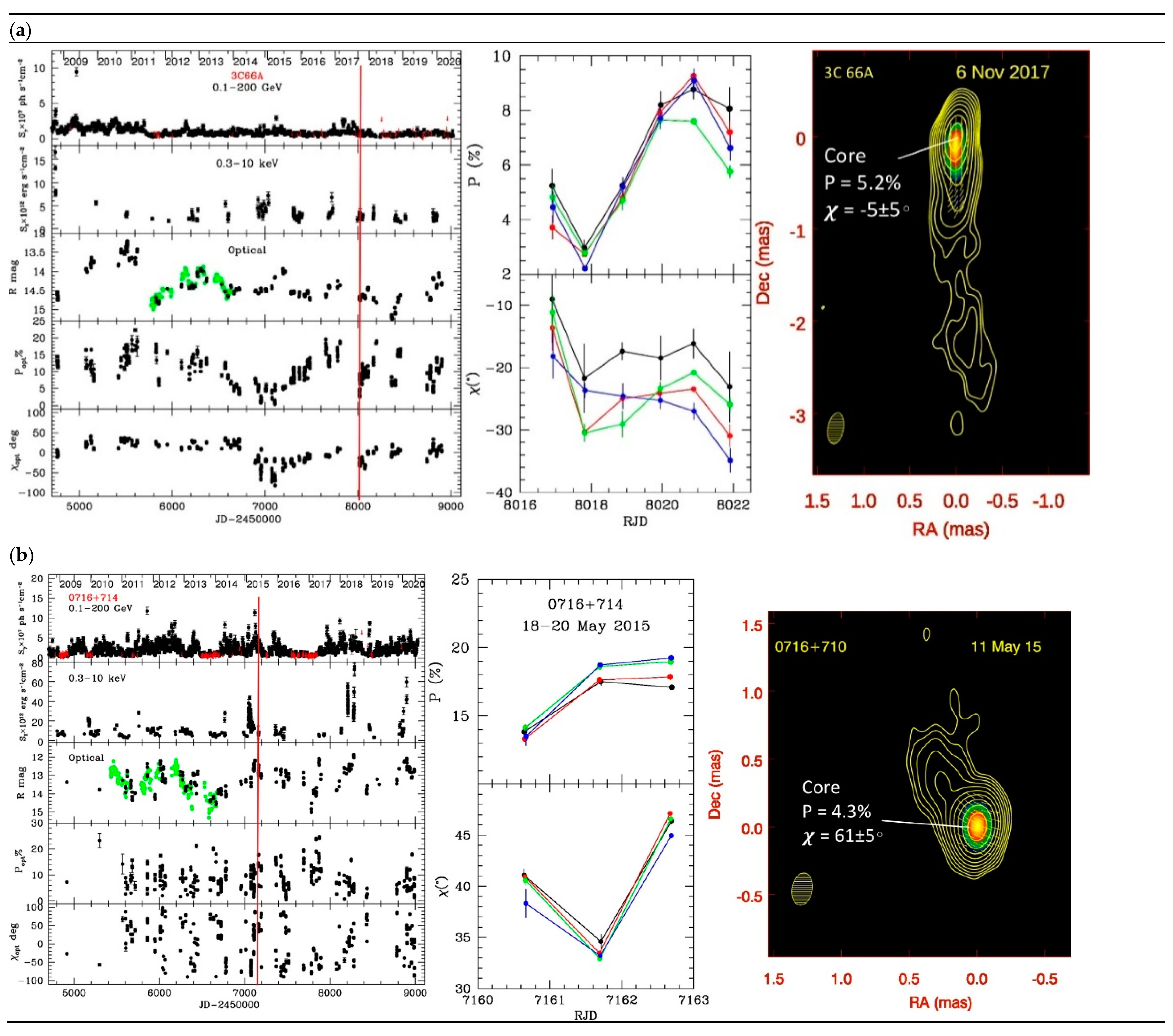

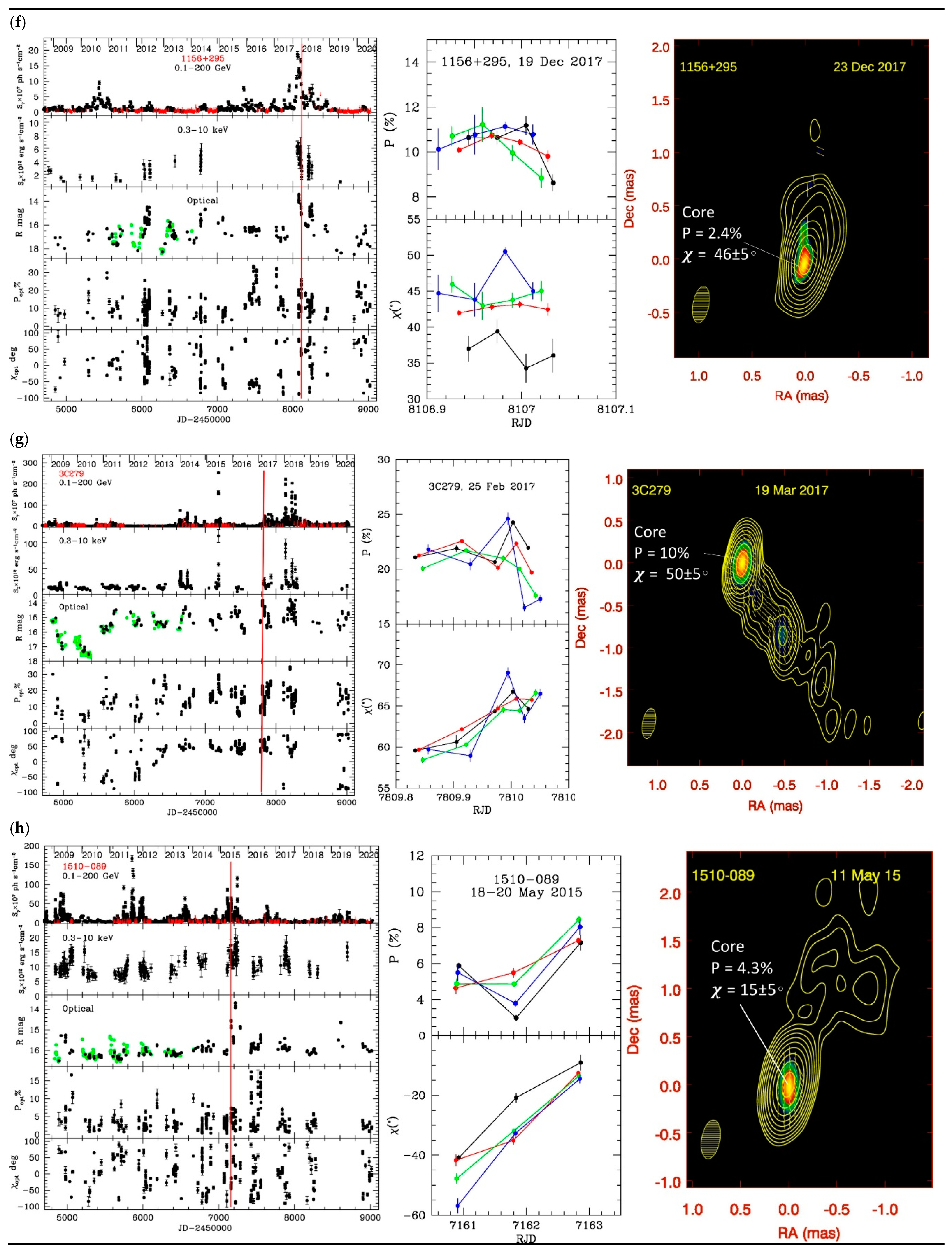

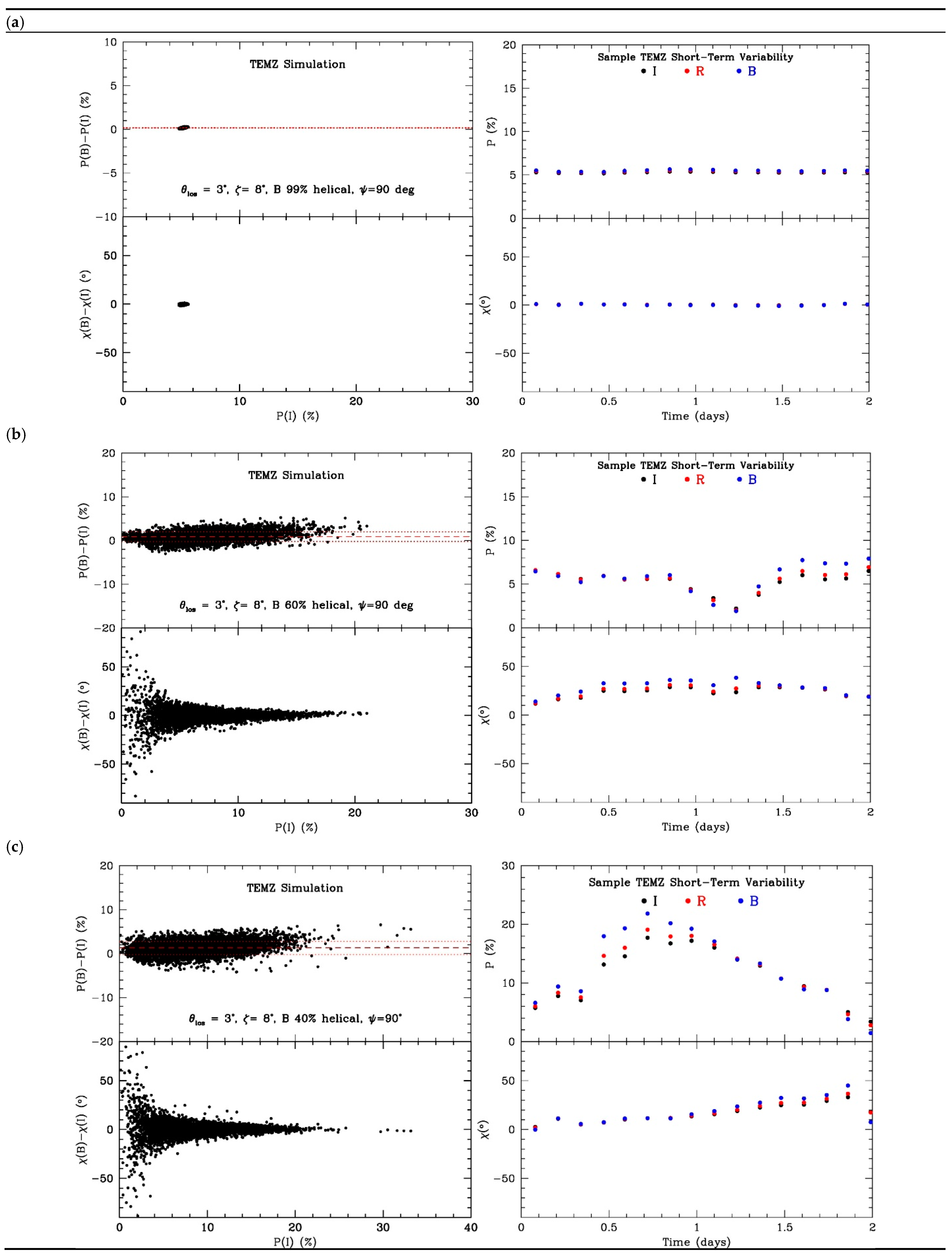
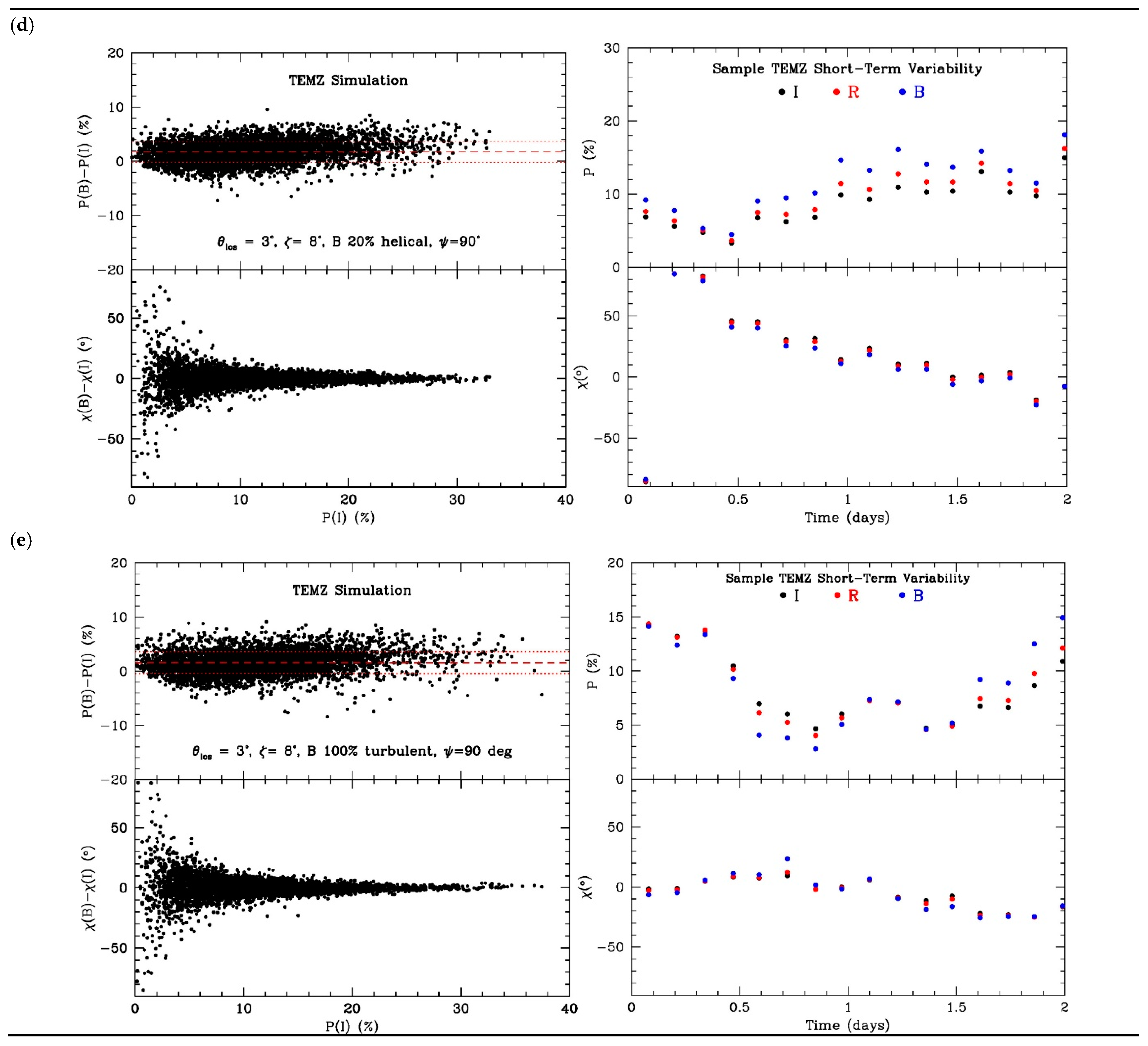
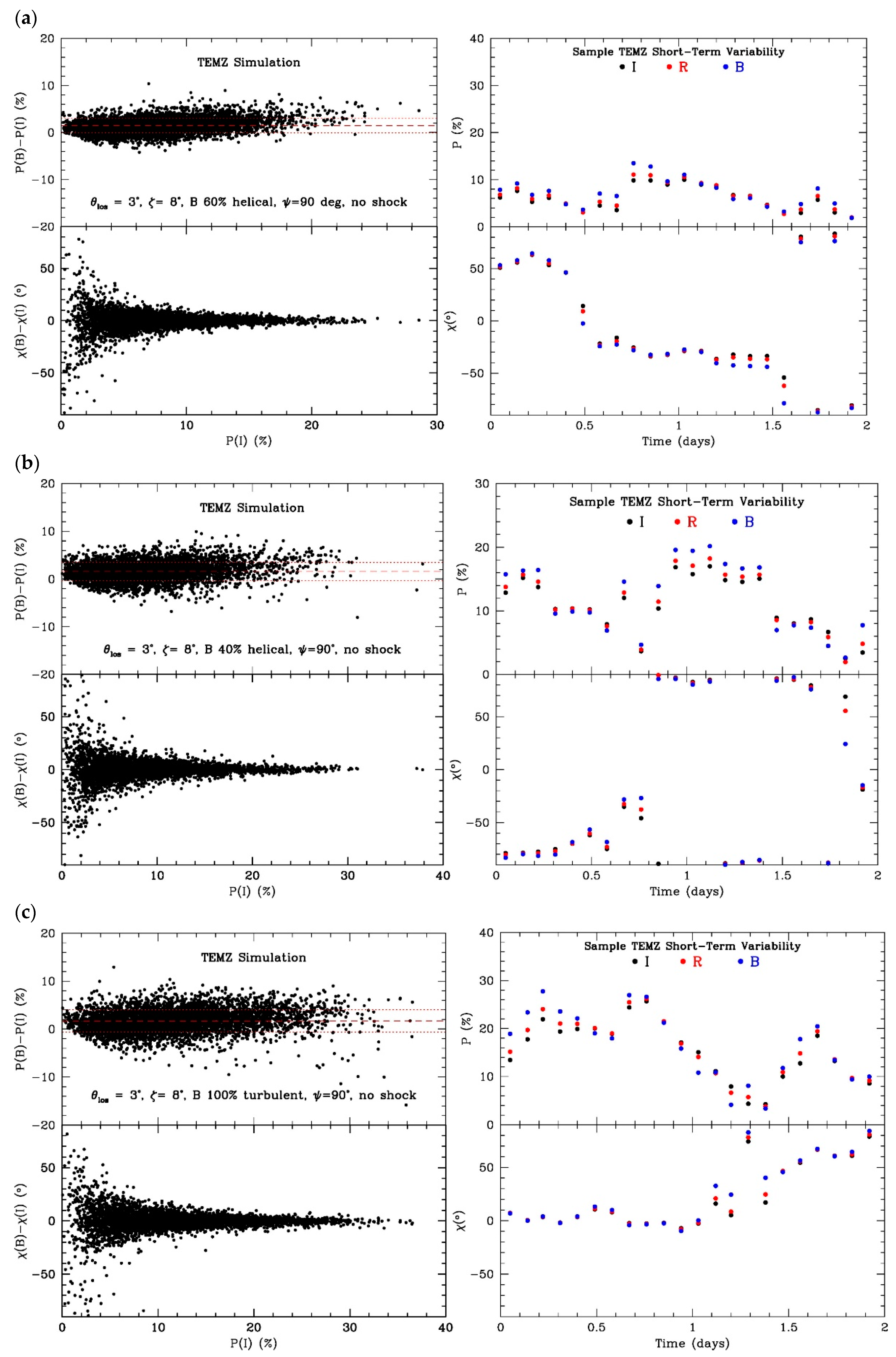
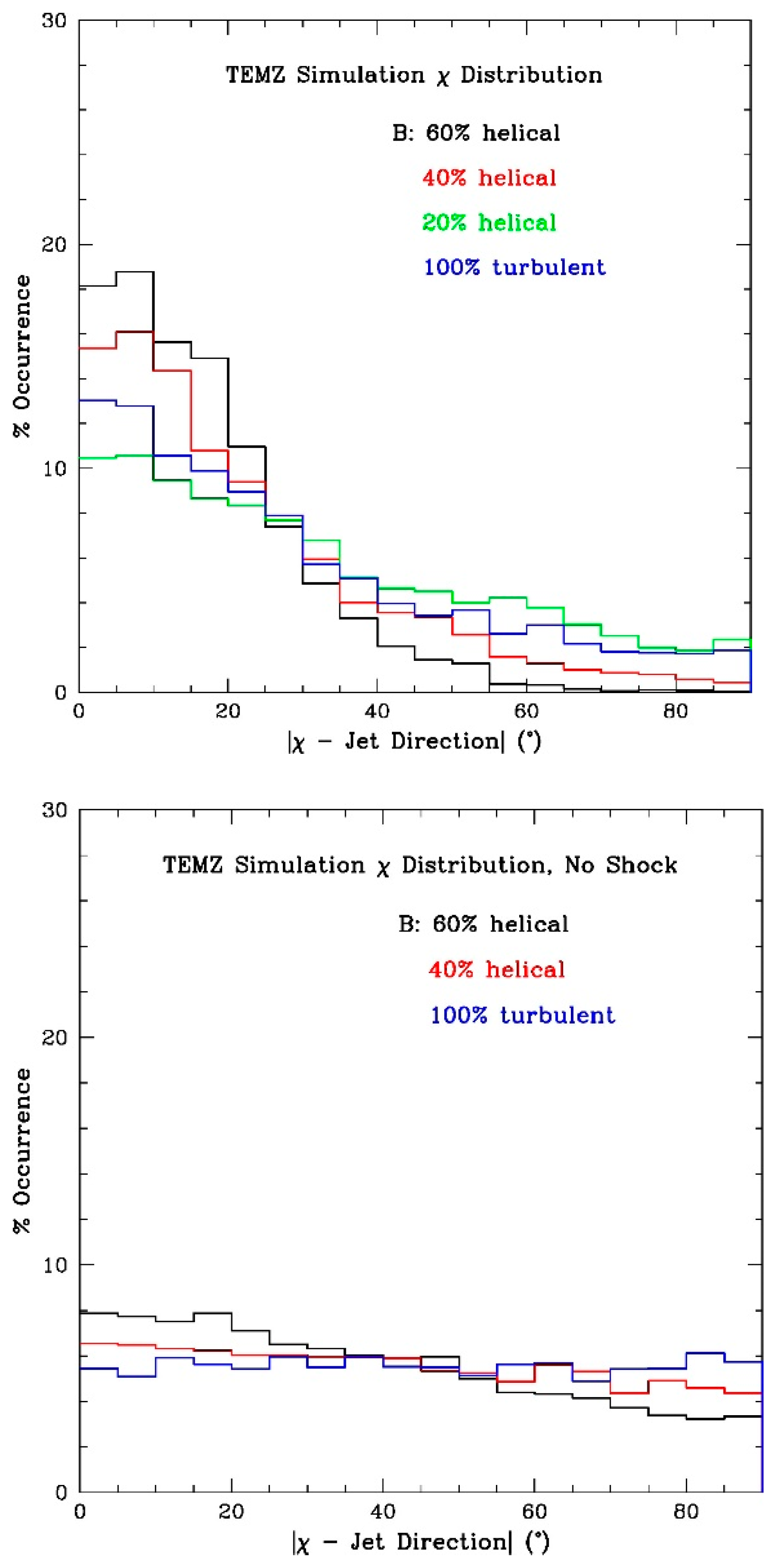
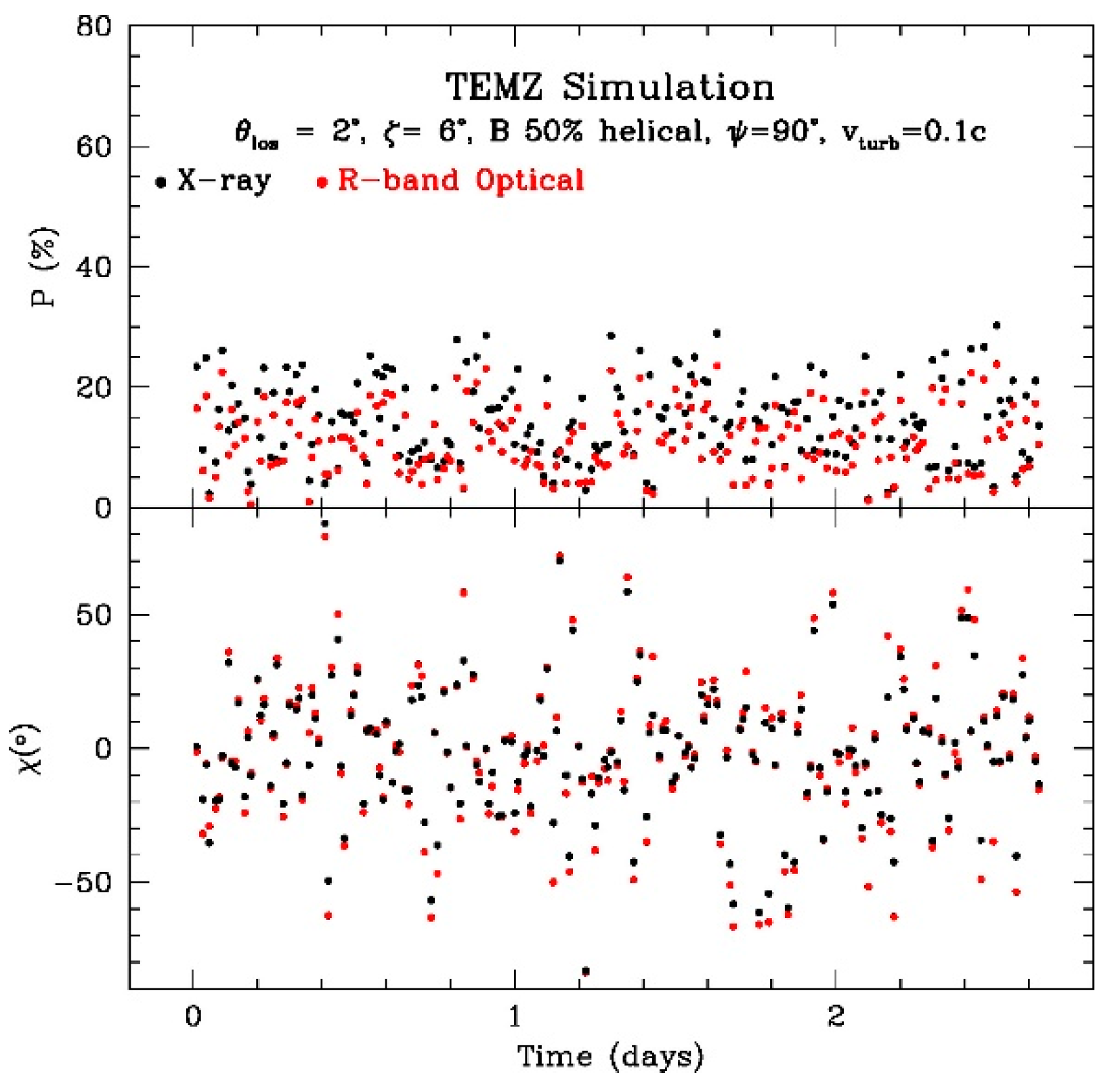
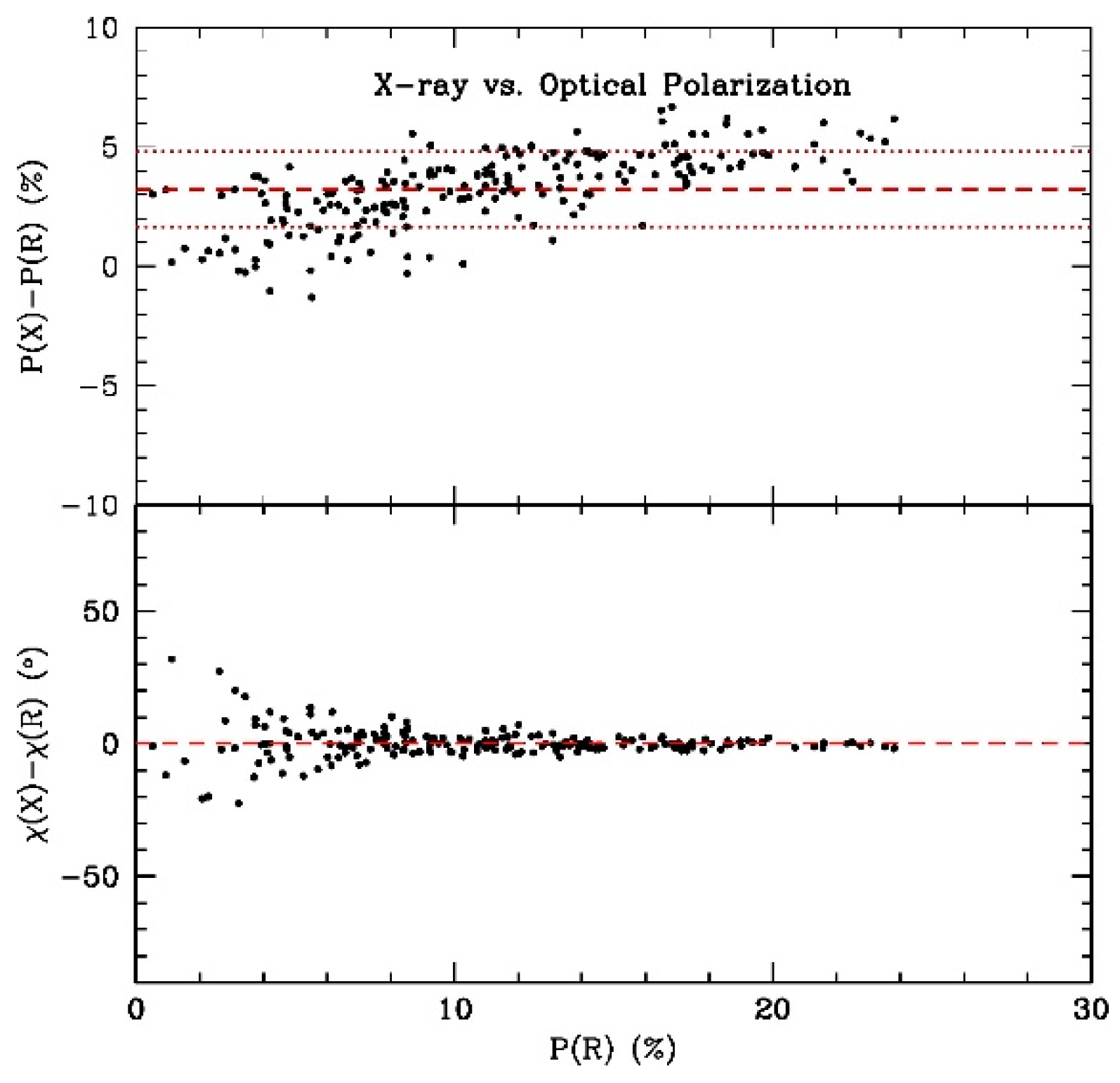
Publisher’s Note: MDPI stays neutral with regard to jurisdictional claims in published maps and institutional affiliations. |
© 2021 by the authors. Licensee MDPI, Basel, Switzerland. This article is an open access article distributed under the terms and conditions of the Creative Commons Attribution (CC BY) license (https://creativecommons.org/licenses/by/4.0/).
Share and Cite
Marscher, A.P.; Jorstad, S.G. Frequency and Time Dependence of Linear Polarization in Turbulent Jets of Blazars. Galaxies 2021, 9, 27. https://doi.org/10.3390/galaxies9020027
Marscher AP, Jorstad SG. Frequency and Time Dependence of Linear Polarization in Turbulent Jets of Blazars. Galaxies. 2021; 9(2):27. https://doi.org/10.3390/galaxies9020027
Chicago/Turabian StyleMarscher, Alan P., and Svetlana G. Jorstad. 2021. "Frequency and Time Dependence of Linear Polarization in Turbulent Jets of Blazars" Galaxies 9, no. 2: 27. https://doi.org/10.3390/galaxies9020027
APA StyleMarscher, A. P., & Jorstad, S. G. (2021). Frequency and Time Dependence of Linear Polarization in Turbulent Jets of Blazars. Galaxies, 9(2), 27. https://doi.org/10.3390/galaxies9020027





